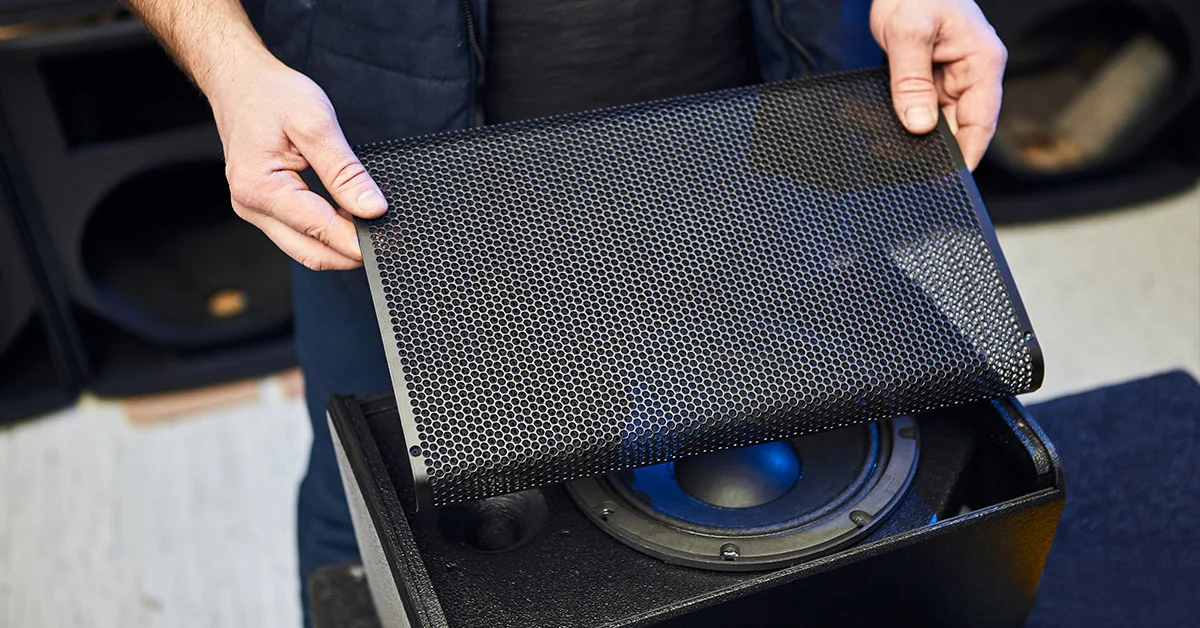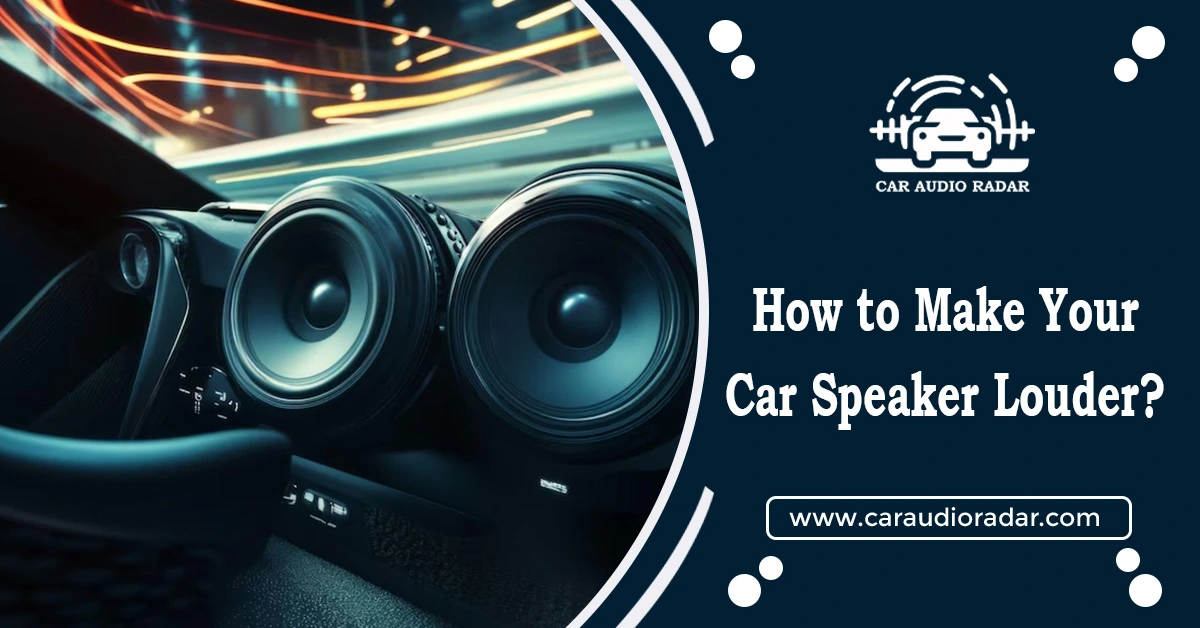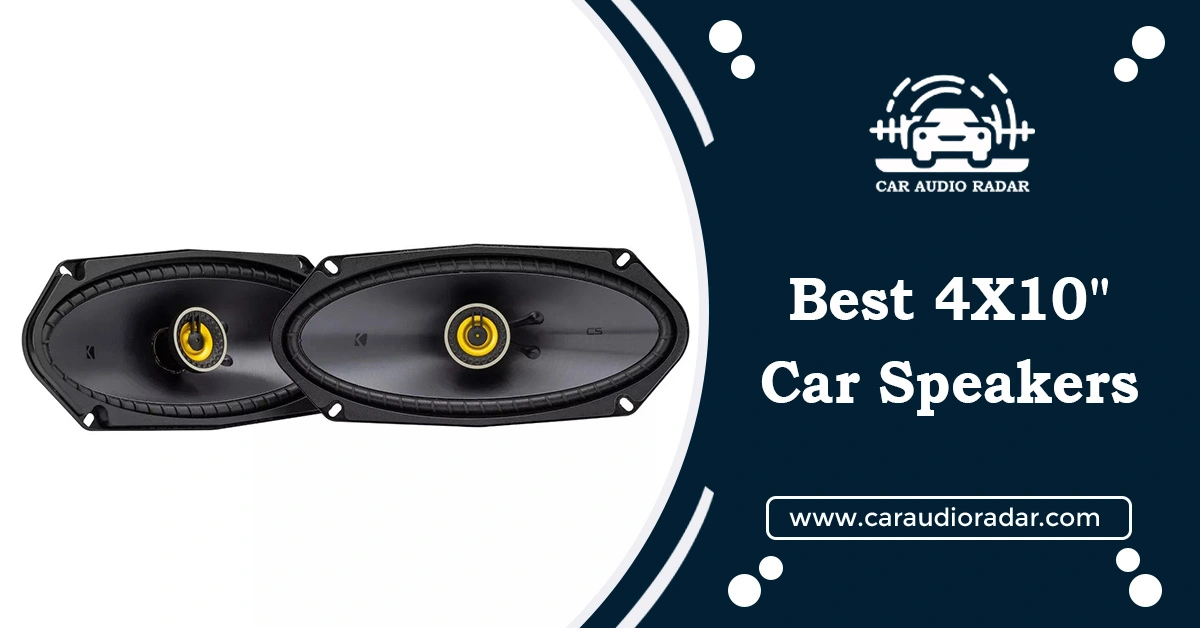
Jump to
Top Solutions: How to Fix Car Speakers Stop Working

Did your car speaker not work? This problem occurs due to loose connections and faulty wires. Are you looking for help on How to Fix Car Speakers Stop Working? Like many electronic gadgets, car speakers can sometimes stop working, which can be frustrating, especially when enjoying music with friends. But why do car speakers fail, and how can you fix them?
This guide provides all the necessary answers to understand and solve common car speaker issues.
Car Speakers Not Working: Causes And Fixes
Car speakers sometimes stop working and figuring out why can be tough for car owners. The reasons are few but tricky to find, especially for beginners in the car world.
Here are some common causes why your car speakers might stop working:
Tools Required to Fix Car Speakers
To fix car speakers not working, you might need the following tools:
- Multimeter
- Drill machine
- Wire strippers
- Soldering iron
- Screwdrivers (flat-head and Phillips)
- Screws
- Pliers
- Fuses
- Flashlight
- Electrical tape
Damaged Signal Wire
Signal wires in a sound system transmit electric signals and data from the head unit to the speakers, which is crucial for optimal sound quality. Identifying damaged signal wires can be challenging when speakers malfunction due to potential issues with other components like speaker wires, the amplifier, or the head unit.
Therefore, a thorough check of all system parts is necessary to ensure proper functionality. Signal wires, typically connecting from the head unit to the amplifier, may suffer damage if improperly plugged in, leading to sparking or signal loss.
Additionally, concealing wires under carpeting exposes them to potential damage from passengers’ feet, while proximity to electrically charged wires can also cause harm. Taking precautions during installation and avoiding exposure to hazards can help prevent signal wire damage and maintain sound system performance.
Fix Damaged Signal Wire
- When installing signal wires in your car,
- Always pass them through the sides of the car interior, not the footrests.
- Passing wires through footrests can lead to them being rolled under passengers’ feet.
- Repeated pressing on the wires can cause them to break and stop working.
- Ensure proper installation by securely pushing the wires into their ports to prevent them from being loose.
Improper Position of Car Speakers can cause them to stop working
Many need help with speaker sound quality despite purchasing top-quality speakers. Proper speaker placement is crucial for optimal performance. When speakers are too close together, their magnetic fields interfere, affecting their function.
This interference occurs due to the repulsion of similar charges and the attraction of opposite charges in magnetic fields. The magnetic components in speakers, such as coils and diaphragms, are essential for sound production.
However, when their magnetic fields clash, it disrupts their performance. To ensure speakers work effectively, they should be placed at least one foot apart to prevent magnetic field interference and allow each speaker ample room to operate correctly.
Fix Improper Position of Car Speakers
- If your speakers are too close together and causing issues,
- The best solution is to separate them.
- If your speakers are mounted on a wooden board or cardboard behind the back seat,
- Get a new cardboard and place the speakers farther apart.
- If your speakers are in soundboxes and they keep coming close to each other,
- Mount the boxes farther apart.
- Make sure to position them wherever you want for better sound quality.
Blown Fuse
Car speakers are protected from too much electricity by a fuse. If there’s too much voltage, the fuse breaks instead of the speakers. It’s easier and cheaper to replace the fuse than the speakers.
How do you know if the fuse is blown? If you try to turn on your speakers but the display doesn’t come on, there’s a good chance the fuse is blown. The great thing about fuses is that you can find them easily and replace them quickly, usually in just a few minutes. So, don’t worry too much.
But if you put in a new fuse and it blows again soon after, there might be a short circuit somewhere that needs fixing. Putting in a stronger fuse won’t fix things if there’s a problem in the speaker circuit. Before you swap out the fuse, figure out why it blew in the first place. If the power and ground connections are fine but the problem continues, another issue might exist.
Fix Blown Fuse
- If the fuse in your speaker blows, there’s a simple solution.
- Locate the fuses in the speaker wire, typically installed by a technician.
- Check all the fuses to see if they are blown.
- Replace any blown fuses with new ones to prevent future issues.
- If the fuse is outside the speaker box, it’s easier to replace.
- If the fuse is inside the speaker box, you’ll need to unscrew the speaker to access it.
- Once you locate the blown fuse, replace it to fix the speaker issue.
Check for Amplifier Issue
A few issues in the amp can make a speaker stop working. For instance, if you turn the volume up too high, the amp might go into protection mode, or one of its channels might be faulty. If your speakers are connected to one amp, check if the amp has any problems.
Fix Amplifier
- Connect the left speaker wire to the left channel and the right wire to the left speaker. Remember to turn off the stereo first.
- Switch on the radio and check if both channels are working correctly.
- If only one channel works, switch off the stereo, unplug the wires, and switch them so the right cable is on the left and vice versa.
- Switch on the radio again to check if both channels work.
- If the same channel still doesn’t work, the amplifier might be the problem since you’ve ruled out issues with other components.
- If one side had a problem, you would have noticed it when you switched the cables. Since that didn’t happen, it suggests the amp is malfunctioning.
- To fix this, having a professional check your amp for any issues is best.
Troubleshooting a Crossover Problem
If your left speakers or any other speakers stop working, ensure you’ve set the correct crossover and phase on your speakers. Switch the RCA cables and turn on the system to troubleshoot the crossover or any intermediate component.
The crossover might be the issue if the right channel works but the left doesn’t. But if the one speaker stops and the right one starts working, it’s probably not a crossover problem.
Fix Crossover
- If the crossover is not working properly, you can repair it or get a new one.
- But remember that installing a crossover can be complicated and needs some know-how.
- For safety and best results, getting help from a skilled technician is a good idea.
When Car Speakers Wires are Pulled Out
Many opt for short speaker wires, either accidentally or to save money. However, using longer wires offers several advantages. Longer wires facilitate easy relocation of speakers and allow for flexibility in positioning.
Moreover, having extra wire length is beneficial if repairs are needed due to damage. On the other hand, short wires can be pulled out, especially if speakers are installed in the trunk or behind car seats.
Movement of the car or items in the trunk can tug on the wires, leading to disconnection. Even if wires are placed under the carpet, they can be pulled near areas where passengers’ feet rest. Therefore, careful wire installation is essential to prevent disconnection issues.
Fix Car Speakers Wire are Pulled Out
Here’s how to extend speaker wires in simple steps:
- If your wire is too short, swap it out with a longer one.
- If not, add extra length by splicing in a new piece of wire.
- Cut the wire where it’s easy to see and strip off the insulation.
- Attach the new wire to the old one for both speaker wires.
- Use Scotch tape to cover the electrical connection securely.
- If the wire pulls out from the trunk, route it along the backseat’s inner surface and through the car’s walls.
Troubleshooting With RCA Cable
The RCA cables connect an intermediate component between the amp and the head unit of the stereo. To test these cables, remove the head unit from the dashboard to access the RCA cables.
Test RCA Cables
- Test the cables between the amplifier and the intermediate component.
- Unplug cables from the component’s output.
- Plug good cables into the bad side.
- For example, if the right channel works:
- Connect the right RCA cable from the amp to the left side of the crossover.
- Switch on the radio.
- If the right channel keeps working, the RCA cables between the crossover and amp might be the issue.
- If the left channel stops working:
- The RCA cables are likely fine.
- Turn off the stereo.
- Connect the right RCA cable from the amp to the left RCA output of the crossover.
- Switch the system back on.
- If the cables are fine, you should hear sound from the right speaker.
- This process helps determine whether there’s a problem with left and right cables or any other component.
- Once you identify the problem, please turn off the radio and return the RCA cables to their original position.
- If the cables are faulty, you may need to fix or replace them immediately.
Fix RCA Cables
To fix frayed cables:
- Cut off the frayed part and peel back about a quarter of the insulation.
- Hold the bare wire against the tab on the back of the RCA input.
- Heat the tab and wire with a soldering iron until hot.
- Touch the solder to the joint until it flows into the connection.
- Let the solder cool.
- After fixing the cables, turn on the stereo and enjoy your music.
Improper Connection of Car Speaker Wires
How can speaker wires be connected incorrectly? It’s pretty simple. Speakers always have two wires connected to the power output of the amplifier, one red and one black. They’re different colors because they serve different purposes regarding electrical info.
Sometimes, people don’t use different color wires for the speakers, and that’s not a good idea. Using different colors helps you know which wire goes where on the amplifier or speaker box. If you can’t tell which wire goes to which port, you can run into problems with your speakers.
So, it’s best to use wires with specific colors to make it easy to identify where each wire should go.
Fix Improper Connection
- If your speakers aren’t working due to bad wire connections,
- You don’t always need to buy new wires.
- Instead, try swapping the two input wires of the speakers.
- Do this either at the amplifier or the back of the speakers if they have pin connections.
- This simple trick often solves the problem without needing new wires.
Fix Car Speaker is not Working on One Side
Here are some steps to fix a car speaker problem affecting only one side:
- Check Balance Settings: Make sure the balance settings on your car stereo are centered or balanced.
- Switch Left and Right Channels: Swap the connections of the left and right channels at the back of the stereo or the speaker to see if the issue is with the audio source.
- Examine Speaker Wiring: Look for any damage, loose connections, or exposed wires in the wiring. Fix any issues you find.
- Test with Different Speakers: Connect a working speaker to the cables leading to the non-working speaker to check if the problem is with the speaker itself.
- Inspect the Speaker: Check the non-working speaker for physical damage. If needed, repair or replace it.
- Check the Radio: If you suspect a problem with the car radio, refer to the manual or seek professional help.
- Get Professional Assistance: If you cannot find or fix the problem, consult a car audio technician for diagnostics and repairs.
Troubleshooting the Head Unit
If your system’s head unit turns on, but you can’t hear any sound from the speakers, don’t immediately assume that the speakers are broken. Just because the unit powers up doesn’t mean it’s functioning correctly.
To make sure everything’s okay, here are some things you should check first:
- Look at the unit’s volume, pan, and fade settings.
- Ensure it’s not in anti-theft mode, which might need a code to unlock.
- Test the switches on the unit.
- Check for any loose or unplugged wires.
- Try different audio inputs like the radio, CD player, etc.
- If your RCA cables are fine, you should test the head unit.
Test & Fix the Head Unit
- Carefully unplug both RCA cables from the unit without disconnecting other wires.
- Plug the right cable into the left channel of the unit and turn on the system.
- If the speaker works, it’s likely not a problem with the head unit.
- This suggests an issue with the cables connecting the unit to the amplifier or intermediate component.
- To pinpoint the problem:
- Switch off the radio.
- Disconnect the right RCA cable.
- Plug it into the left RCA output to test the cable.
- The head unit might be the issue if the right speaker doesn’t work on the left channel.
- The head unit and the RCA cable could be faulty in rare cases.
- If the head unit is defective, have it checked by a professional or consider replacing it.
Check for Continuity
If you’ve checked everything else and still have issues, it’s time to look at the speaker. Whether it’s rear speakers in a car or any other speaker, the troubleshooting car audio method is the same in different locations.
To troubleshoot, turn off the stereo and disconnect the speaker wires. Then, connect the left speaker output to the right amp output and turn on the radio, keeping the balance in the middle.
If the speaker still doesn’t work, the problem might be between the speaker and the amp. It could be a wiring issue, the speaker wire, or the speaker itself. Even a passive crossover could be causing trouble.
To pinpoint the problem, you must take out the speaker and run some tests. This might involve removing it from the door speaker or trunk. Once you have the speaker out, test it on the amplifier.
If the speakers are working, then there’s a problem with the wiring. If it still doesn’t work, the speaker is likely the problem.
Fixing Car Sound System Speakers
If you’ve tried everything else and the speaker still isn’t working, it’s time to focus on the speaker itself. Whether it’s a rear speaker or any other speaker, the troubleshooting process is similar:
- Turn off the stereo and disconnect the speaker wires.
- Swap the left speaker output with the right amp output and turn on the radio, keeping the balance in the middle.
- If the speaker still doesn’t work, there might be an issue between the speaker and the amp. This could be due to a wiring connection problem, an issue with the speaker wire, or a problem with the speaker itself. A passive crossover could also be causing issues.
- To narrow the problem, remove the speaker from its location, whether in a door channel or the trunk. Test the speaker directly on the amplifier.
- If the speaker works when connected directly to the amp, then the issue is likely with the wiring. If it still doesn’t work, the speaker may be faulty.
Test & Fix Car Speakers
- To check if the wiring is causing the problem:
- Get new speaker wires.
- Connect them between your speaker and amp.
- If the speakers work with the new wires, it’s likely the old wiring is faulty.
- Replace the old wiring with quality speaker wires to fix the issue.
- If the wiring is not the problem and everything else checks out:
- Check for continuity and ground.
- If the speaker still doesn’t work, it might be faulty.
- Consider replacing your car speaker.
- This could be a good opportunity to upgrade your car’s audio system with aftermarket speakers for better sound quality.
- When purchasing speakers, ensure they are the correct size for your car and of good quality.
- To check if the wiring is causing the problem:
Tips for Fix Car Speakers Stop Working
- Check Wiring Connections: Look at the wires connected to the back of the speaker. See if they’re damaged, not connected properly, or rusty. If you find any loose wires, fix them.
- Verify Connection to Head Unit: Ensure the speaker is plugged into the head unit, which controls the car’s audio. If it’s not connected well, the speaker might not work right.
- Test with Different Speakers: Try connecting another speaker to the same wires to see if the problem is with the speaker or the wires. If the new speaker works, the old one’s likely faulty.
- Check Speaker Fuse: Find the fuse for the speaker that’s not working and check if it’s blown. If it is, replace it with a new one.
- Inspect Amplifier: If your car has an amplifier, check its connections and settings. A broken amplifier can also cause speaker problems.
- Ensure Proper Grounding: Ensure the speaker and amplifier are grounded properly to the car’s body. Bad grounding can mess up how the speaker works.
- Test Signal Source: Double-check if the audio source works correctly, like the head unit or media player. Make sure it’s sending signals to the amplifier or speaker.
- Consider Professional Help: If you can’t fix the problem yourself, consider getting help from a car audio technician. They’re experts who can figure out and fix the issue for you.
Conclusion
With these tips and fixes, you should now know better what might be causing your car’s speaker problems and how to deal with them. Always remember to stay safe—disconnect your battery before working on anything electrical.
Sometimes, the easiest fixes work best, but it might take some time. Once you’ve solved the problem, relax and enjoy the great sound from your car’s speakers. Hopefully, now you will get a brief answer on how to Fix Car Speakers Stop Working. And can fix your car speaker seamlessly.
Frequently asked Questions (FAQs)
Often, it happens when the volume is turned up too high, putting too much power through the speaker and causing the coil inside to get too hot and stop working.
Blown speakers can produce a crackling sound, distort audio, or have no sound at all.
Distortion at medium to high volumes, rattling, and lack of clarity can all be signs of speaker damage.
Yes, water or moisture can damage vehicle speakers, leading to malfunctions on one or both sides.
Higher power (measured in watts) means louder and cleaner speaker performance. However, minor power differences may be challenging to hear. The power must double to listen to a difference, like a 3dB increase.
The factory stereo system performs all necessary functions but needs to improve sound quality. To enhance audio performance, consider upgrading by replacing speakers and adding an amplifier. This applies even to so-called premium systems.
Cooper Katzeel
Car Enthusiast
Cooper Katzel, a dedicated car enthusiast, delves into the world of automobiles and audio systems. With a deep interest in cars and a focus on superior sound, Cooper’s expertise traverses the spectrum. His journey is a delightful exploration of automotive wonders and the world of car speakers. Cooper’s passion and technical know-how make him a trusted advisor for car enthusiasts.
Follow On Instagram
Recent Posts
- All Post
- Blog
- Car Speaker
- Car Subwoofer
- Pro Tips & Guides
- Back
- Speaker Wire



Dream Life in Paris
Questions explained agreeable preferred strangers too him her son. Set put shyness offices his females him distant.


